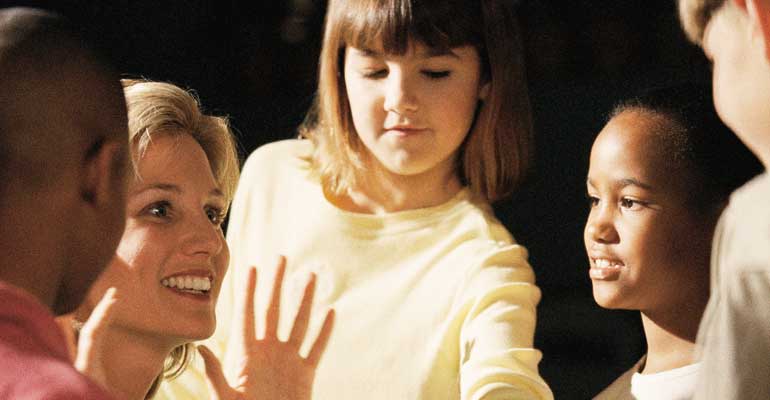Early in first grade at my daughter’s school, each child is given a special day when she gets to help the teacher in prominent ways and make important choices (like who gets to stand first in line). Classmates interview the child of the day, and the teacher records the answers on a big poster.
My daughter was the first of two adopted children in her class to have a special day, and inevitably questions about adoption came up — although, the teacher reported, they were afterthoughts. The class had just finished interviewing my daughter, and the teacher was about to move on, when a classmate asked, “Weren’t you adopted?”
I got a message from the teacher that afternoon saying that adoption had come up and that my daughter had handled the situation with confidence and pride. The teacher then read to the class a book called Families Are Different.
In it a girl adopted transracially from Korea talks about her white parents, her Korean sister, and the occasional discomfort of being different from other families. But she looks around the neighborhood and notices that while in some families everyone looks alike (even the dog), in others there are many differences. All families, she concludes, are held together “by a special kind of glue called love.”
I was glad the teacher had read the book, and I was gratified to hear that my daughter had enjoyed her special day. So I was surprised, when I picked up my daughter that afternoon, to see her looking sad. It turns out that the interview was fine. She had enjoyed talking about herself and didn’t mind the questions about adoption. She loved the book and was pleased that her teacher had read it aloud. But there was still a problem.
One child had asked if the two adopted girls in Families Are Different were real sisters. And the teacher had answered, “They’re kind of sisters.” It’s possible that no one except my daughter picked up on the subtext of that answer. But some kids catch all the nuances when grownups are talking about adoption. Mine has her radar fine-tuned.
She heard that the teacher wasn’t sure just how “real” those sisters were. My daughter doesn’t have a sibling, but she has adopted friends who do. Weren’t Betty and Zoe real sisters, she asked?
I explained that sometimes grownups not in adoptive families aren’t always good at answering questions about adoption. What’s confusing, I explained, is that before Zoe was adopted, she and Betty weren’t sisters, but that from the moment of adoption on, they were sisters forever. And by the way, would she like me to come talk to the class about adoption next week?
Adopting Emma
At the beginning of the school year, I’d given my daughter’s teacher a packet of materials on adoption and school issues. The teacher had invited me to give a talk on adoption, but I hadn’t scheduled it yet. I wished I’d done it before my daughter’s special day, but after would have to do.
I was nervous about talking to the class, so I asked several parents who’d done it before for some suggestions. Then I talked with my daughter. She had a terrific idea. She has a doll named Emma who was made to look like her when she was one year old. “Let’s dress Emma in my orphanage clothes,” she said, “and we can talk about Emma’s adoption.”
And that’s what we did. The class loved it, and everyone wanted to hold the “baby.” My daughter was a participant in the discussion rather than the subject of it, which really pleased her.
We talked first about different types of families, how some look alike and some don’t. In my daughter’s school a third of the children are biracial so it’s not just transracial adoptees who look different from one or both parents. We used this realization as a springboard to discussing adoption.
Together we made two lists on the black board. On one side the children named things that babies need: diapers, bottles, food, clothes, hugs, love, and so on. On the other side they listed what parents do: feed, clothe, and hold babies, change diapers, give medicine. None of the first-graders said anything about being born. At the top of the parents’ list I added a crucial part of every child’s story: babies need parents to bring them into the world.
You have to be careful how you talk about birth with first-graders. At this age there’s a wide range of knowledge about procreation. Some six-year-olds can give accurate anatomical names to all the relevant body parts, while others know only that a baby grows in a mother’s tummy. One boy in the class insisted that babies come from the earth. While some of his classmates shouted corrections, I redirected the discussion. I wasn’t there to teach the birds and the bees.
A Job for Emma’s Forever Parents
Once we had our lists of what babies need and what parents do, I moved on to adoption. I told them to remember that adoption happens for grownup reasons and that the need for adoption is never, ever a child’s fault. Birth parents sometimes have big problems (like being too young to be parents or, in some parts of the world, being afraid to break rules about how many children they can have).
Because of a big grownup problem, some birth parents decide that they can’t be “forever parents” to their child. I put a circle around “bring babies into the world.” I picked up Emma, the doll, and said, “Emma’s birth parents could bring her into the world, but they didn’t think they could do all these other things,” and I pointed to the long list of things babies need and parents do.
“Emma’s forever parents,” I explained, “adopted her because they wanted to do all those other things for her. But they didn’t do the first thing: they didn’t bring her into the world. So Emma has two sets of real parents: her birth parents, who are certainly real even if we don’t know who they are, and her forever parents, who are also real and who are part of her real forever family.
I don’t know if it was the doll or the lists, but for most of the kids something clicked. They were excited to understand something concrete about adoption, and my daughter was proud of the whole thing — especially the interest everyone took in Emma’s clothes.
“Those were really my clothes,” she confided to the class, to general acclaim. When the other adopted child in the class had her special day, no one asked about adoption. They knew enough for now.
What worked here may not work for your child. It may not even work for mine next year, when new questions and concerns may arise. We can’t deal with the issue once and consider it done, because understanding and talking about adoption is a lifelong process.
We need to keep communication open with our children so we know (or can make educated guesses about) what issues are coming up in school and can help them, their friends, and their teachers develop greater awareness and understanding of adoption.


